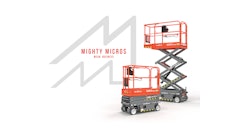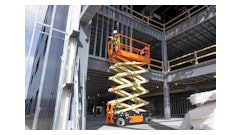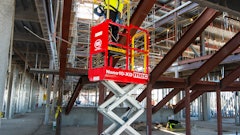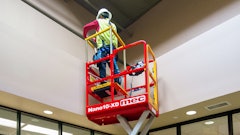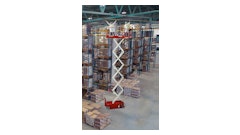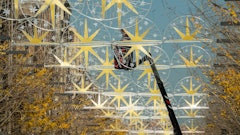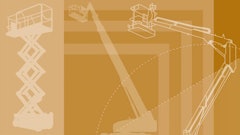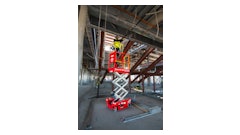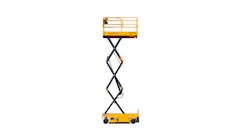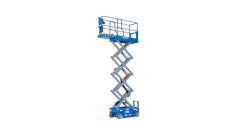
Product innovations and a strong commercial construction market have combined to drive up the demand for scissor lifts. With expanded workspaces, improved stability and increased lifting capabilities, they have become indispensable in many construction and industrial applications.
"The market demand for scissors is strong," says Jeff Ford, product champion for JLG Industries’ scissor lift line.
Especially popular are the narrow-chassis, 26-foot lifts, which are rapidly replacing the 20-foot lifts that have been the industry standard for many years. Their compact width - 32 inches or less - allows operators to maneuver the lifts through standard, single-size doors.
"People are thinking why buy a 20-foot lift when you can get a 26-foot lift that goes all the same places and more?" says Tom Stachurski, vice president with Haulotte USA.
Rick Sellers, sales manager for Aerial Lift Service Company in Sacramento, CA, agrees with Stachurski's assessment. "With the newer, compact lifts, you can go through narrow doorways and work in a congested area or narrow aisle," he says. "Both the compact size and height are benefits."
Tackling rough terrains
There is also growing demand for rough-terrain and dual-deck units as well as lifts that can be driven in fully heightened positions. Rough-terrain lifts have been equipped with load management devices to help them negotiate steep grades.
"These rough-terrain lifts are very good machines for commercial construction," Stachurski says. "This was a dead area for a few years in the United States because construction spending was down, but now it’s coming back."
In the United States, Haulotte offers several diesel-powered, rough-terrain scissor lifts with a reach of up to 59 feet. In Europe, Haulotte has introduced compact, electrically powered lifts that can be used both inside and outside buildings. With a working height of 30 to 36 feet, these lifts feature rear-wheel drive and high ground clearance, which allows them to traverse a wide variety of terrains.
Genie Industries' rough-terrain scissor lifts, which can be powered by gas, diesel or propane, offer working heights up to 59 feet and feature automatic-leveling hydraulic outriggers for added stability. JLG's rough-terrain scissors can be diesel or gas powered and feature working heights of 26 to 43 feet.
Elevated work spaces
Besides increasing reach and condensing chassis, scissor lift manufacturers have made their equipment more versatile with larger (and expandable) decks where operators can easily work with table saws, welders and other tools.
"Your basic slab unit today has to have an extended deck, smooth control operation, tight steering-turn capability, automatic chargers for refreshing batteries and non-marring tires," says Stachurski. "Many of these items were options in the past."
In addition, lifts are being equipped with special accessories for specific applications. JLG's "Workstation in the SkyTM" lift accessories include a workbench with compartments for a reciprocating saw, drill, circular saw and other power tools; a rail-mounted vise, pipe racks, a wire-spool holder, a panel carrier or a welder. In addition, the workstation features a built-in tray that can be pulled out to provide a flat working surface near the top of the rails. These customized accessories allow lifts to carry up to 200 pounds of pipe or drywall. JLG's SkyPositionerTM accessory, designed for HVAC and sprinkler systems, can accommodate 1,000 pounds of ductwork up to 52 inches wide and pipe up to 8 inches in diameter.
"(The SkyPositionerTM) allows the operator to slide pipe into overhead hangers without the risks associated with manual lifting," Ford says.
Storing pipe or conduit outside the platform area also reduces trip hazards and improves workflow. "Scissor lifts fitted with customized accessories can store materials without cluttering the floor or damaging the railings," says Ford. "Productivity is increased because more can be taken to the work area."
Improving functionality and performance
Manufactures have also made scissor lifts more durable and easier to operate. Many feature joystick controls that facilitate one-hand operation.
Genie's GS series is powered by variable speed motors that provide the precise amount of energy needed at the time, which increases both battery and motor life.
JLG's Pro-Fit Series features an electric drive system that utilizes independent motors to power the drive wheels. This approach provides longer duty cycles and reduces the noise and power loss associated with pumps, hoses and hydraulic motors. In addition, Pro-Fit's hydraulic system combines the lift pump, reservoir, motor and lift cylinder in a single assembly, reducing the number of potential leak points.
"There have been vast improvements made and I believe this will continue as a trend in the industry," Stachurski says. "Longer life batteries, smarter chargers and troubleshooting capabilities will continue to improve."
Ford says versatility has become essential in the scissor lift market. "End-users prefer a dependable, leak-free lift that has a battery life that can last multiple shifts and the capacity to lift plenty of materials and operators," he says. "They also want narrow widths and maneuverability for accessing narrow spaces."
But even with an increased demand for versatility, the basics are still important. Says Stachurski: "I still think it comes down to the three basic needs: price, dependability and if it fails, fix it quick."
When selecting scissor lifts ...
Electric, diesel, gas or LPG? This depends on the application. Electrically powered scissors are a must for indoor applications but can be used outside as well. The use of diesel- and gas-powered units increases with the toughness of the terrain on which the lift will be used because they are less likely to get bogged down negotiating steep grades.
Capacity. The load-carrying capability of lifts varies greatly even if they have the same vertical reach. An electric-powered, narrow-chassis lift with a 33-foot reach has less than half the carrying capacity of a diesel-powered, rough-terrain lift with the same reach.
How high do you need to go? It's important to understand the difference between working height and platform height. Working height is the maximum height at which a typical worker could normally operate with the lift fully extended. This is the height at which most lifts are rated. Platform height, the distance between the platform floor and the ground when the lift is fully extended, is generally about six feet less than working height.
Battery life and charging capabilities. Battery life is a critical issue for electric lifts. It’s important to know the duty cycle of batteries and how efficiently they can be recharged.
Not surprisingly, lift manufacturers have made great progress in making equipment more energy efficient, extending battery life and improving the recharging capabilities.
The SuperCharger, a waterproof charger developed by UpRight Inc., can re-energize batteries on Upright’s smaller lifts to 98 percent of their initial strength.
Ground clearance and gradeability. Ground clearance and gradeability (the steepness of terrain a specific lift can negotiate) vary considerably by type of lift and manufacturer.
Electric lifts typically have ground clearances of between three and four inches with gradeability ratings of 25 to 45 percent. Rough-terrain lifts have ground clearances ranging from 10 to 14 inches with gradeability ratings ranging from 35 to 50 percent.






